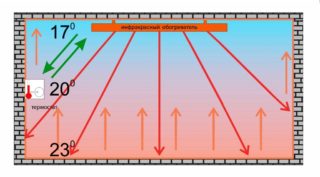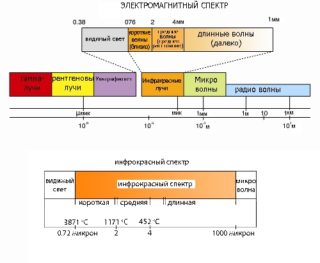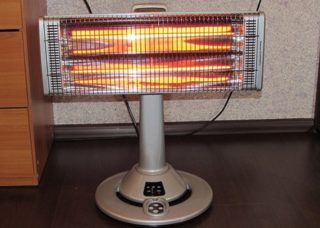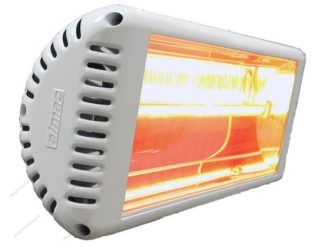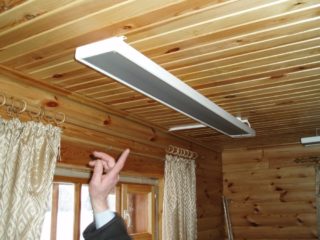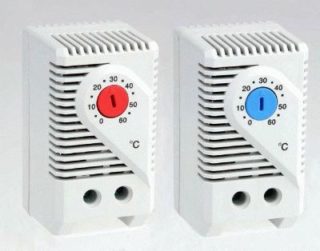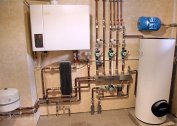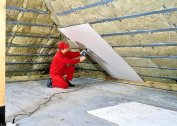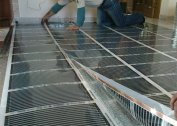Maintaining a constant temperature in the house is the most important task. In the cold season, various types of heaters are used, which include infrared models. To understand whether an IR heater is suitable for a particular house or apartment, one should consider its operating principle, varieties, as well as all the positive and negative sides.
Types of infrared heaters
The principle of operation of infrared, infrared and ultraviolet heaters is similar to exposure to solar radiation. Radiant heat warms a person, overcoming the air. Due to this, the efficiency of the product increases. Also, the walls of the room and objects located in it, which then reflect heat, are heated.
There are different types of infrared heaters by type of energy. These include electric, gas and liquid fuel models. In everyday life, electric and gas heaters are usually used.
Electric heaters
Such models of infrared heaters can be divided into two groups - light and dark. Light is also called shortwave. As a heating element, they use glass tubes, inside which a spiral is placed. They can warm up to 600 ° C and above, and also emit bright light. The heating is very intense in the direction the heating elements are facing. Dark (long-wave) heaters are heated to temperatures below 600 ° C. Available in the form of panels and films. The average operating temperature ranges from 300 ° - 400 ° C. They can be mounted on ceilings and walls. It can be connected for a long time, since such products do not overheat a person.
When voltage is applied to the heating part, thermal energy is converted into electromagnetic waves. These waves shine in the infrared. To prevent waves from spreading around the room, a special metal reflector is used.
They produce infrared heaters with short (from 2 to 4 meters), medium (3-6 m) and long-range (from 6 m) action. This is influenced by the wavelength of infrared rays. Depending on the range, heating devices can be used both in apartments, cottages and cottages, and in production facilities for heating workshops.
There are vertical and horizontal models. According to the installation method, floor products, wall and ceiling, are distinguished. They can work effectively indoors and outdoors. Available in the form of heating film and panels.
Gas infrared heaters
Such devices are used less frequently. Their principle of operation is similar to electrical. The device emits radiant heat, which is created by a heated ceramic plate. Heating is done by supplying natural gas and air, which are connected in a mixing chamber. It produces flameless combustion, which transfers its heat to the porous plate. The formed infrared rays depart from the ceramic plate.
The advantages include the mobility of the device. It works from a cylinder, which can be placed next to or removed from the device and supply gas through a long hose. The cylinder can be installed inside some designs of heaters.
Varieties of gas infrared heaters:
- Household. They are used in apartments, in summer cottages, in greenhouses made of polycarbonate.
- Marching. For installation in a tent.
- On a rack for street cafes and viewing platforms.
Despite their advantages, gas devices are less commonly used. This is primarily due to the high risk of gas leakage. Water heaters and other types are practically not used.
Types of heaters by type of installation
In total there are 3 ways to install infrared heaters: floor, wall and ceiling.
Floor models are used when mobility is important. They are used for temporary heating of cottages and apartments. To ensure safety, overheat protection units and various sensors are installed in many models to de-energize the system in case of emergency. The cost of heaters is several thousand rubles.
Wall heaters are considered an alternative to classic heating radiators. They can be used for additional heating or to create a basic heating system. They have a stylish appearance. In stores you can buy models with exclusive finishes.
Ceiling devices are suitable for heating rooms with high ceilings (trading floors, offices, residential buildings). Actively installed in children's rooms. Outwardly similar to ordinary fluorescent lamps and do not spoil the interior. Most often set for additional heating. They are inexpensive, but investments in high-quality and reliable installation may be required.
Types of heating elements
Regardless of the installation location, one of four types of the main part can work in infrared heaters. Halogen, carbon, ceramic tubular heating elements can be used.
Halogen heaters have a filament, which is made of tungsten. Golden light is emitted. This is the cheapest and most harmful option for heaters.
Carbon models are a quartz heater with a filament, which is made of high-temperature carbon. It quickly warms up and gives light. The disadvantage is high energy consumption. They have the highest efficiency. The spectrum of radiation is safe for humans. Not suitable for continuous continuous operation.
Ceramic devices have a special ceramic shell that traps visible radiation. Possess good durability and profitability. Moisture resistant. The disadvantage is that they warm up for a long time and cool down after turning off. Are applied in floor and wall models.
Tubular infrared heaters with a heating element are considered the best for long-term use. Do not emit harmful waves and substances. Minus - a small sound when turned on and off.
Advantages and disadvantages
Infrared heaters have their positive features, due to which they are actively used for heating.
- Low cost.
- Simplicity of design. The simplest is an infrared film for heating.
- Ease of connection.
- Direct heating. Radiation acts directly on people and objects, bypassing the air.
- The heating rate of the infrared emitter. Heat is given off immediately after the coil heats up, it takes about 30 seconds.
- Profitability. Since it takes a little time to heat up, and all the energy is spent on supplying heat to a person, the power required to work is small. The average power is 500 watts in contrast to the oil heater with a load of 1500-2000 watts.
- No convection flows. Rays propagate to a specific place on a given vector and do not depend on the location height.
- Silent operation of infrared panels. Since there are no fans or coolers in the device, there is no noise from a working heater.
- Local heating in a specific part of the room.
- The ability to install an outdoor electric street heater.
- Duration of work.The absence of moving parts leads to the fact that there is nothing to break in the heater. This also leads to ease of maintenance.
- Environmental friendliness. The device does not emit harmful substances and does not produce by-products. There are no harmful materials in the composition.
- Various mounting schemes.
- Connection of various thermostats, sensors and regulators for safety.
Due to its high mobility and unpretentiousness, the heater can be installed in different conditions without buying other models in return.
The disadvantages include the following factors:
- The temperature drops quickly when you turn off the network.
- Uneven heating.
- Negative effects with prolonged use. Problems can occur if a person is constantly under the switched on device. The damage is the same as from prolonged exposure to direct sunlight.
- Danger to children and animals. If you touch a spiral heating element or flask, there is a risk of burns. To warm the room with children, it is better to choose ceiling models.
- Bright light.
- High risk of fire of high temperature models.
After studying all the pros and cons of infrared heaters, you can make a choice.
Selection tips
When choosing, you need to pay attention to the following indicators:
- Power. It should be calculated in advance. On 10 sq.m. 1.2 kW of electricity is required.
- Design features. These include the installation method and type of heating element.
- The presence of additional factors - a temperature controller for an infrared heater, constant temperature support, the presence of different sensors, the ability to use a remote control.
- Appearance. The case must be strong, without scratches and dents, all parts must be firmly fixed. Passport and warranty card must be attached to the device.
The user should choose a model based on the following algorithm:
- Decide for what purpose a heater is being purchased.
- Choose an installation location.
- Calculate power over the area of the room.
- Take into account the cost of the product.
- Choose a device for all the necessary requirements.
You need to buy an infrared heater in a professional store from well-known manufacturers. You should not take cheap models, as they may not correspond to the declared characteristics and will slightly warm the room.
Popular manufacturers include Mister Heat, Ballu, Eberle 3563 products, as well as the Russian Almak, Resanta and Peony. Often installed model Mr. Hit IR-2.8.
